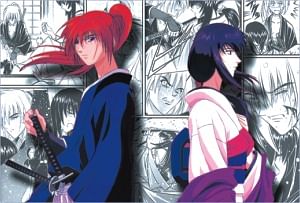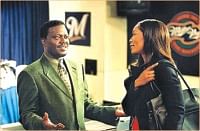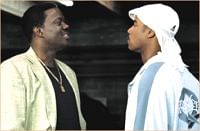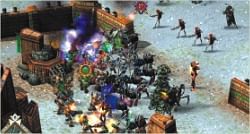anime
TV series Samurai X
by Lancer
 Rurouni
Kenshin: Tsuiokuhen (AKA Rurouni Kenshin: Reminiscences and Samurai
X: Trust and Betrayal) is one of those gems of art that transcends
genre, medium or language to tell you a story that you can't help
but be moved by.
Rurouni
Kenshin: Tsuiokuhen (AKA Rurouni Kenshin: Reminiscences and Samurai
X: Trust and Betrayal) is one of those gems of art that transcends
genre, medium or language to tell you a story that you can't help
but be moved by.
A prequel to the
immensely popular and DEFINITIVE sword master anime TV series, Rurouni
Kenshin (known as Samurai X to the people who saw the English dub
and thrive mostly on Pokemon) Tsuiokuhen is the story of a cold-blooded,
clinical assasin of the Japanese Civil War and how he becomes the
well-beloved pacifist character of the TV series. Briefly, Himura
Kenshin is the man known as the Hitokiri Battousai, the single most
feared man of the Revolution, a swordsman without parallel and without
mercy. Never touched in battle, he is one day, during a "routine"
job grazed on his left cheek by one of the guardians of a target.
The anime proceeds to tell of how he ceases to kill, and takes up
a reverse blade to atone for the murders by his hand, and the story
of the famed cross-scar of the Hitokiri Battousai (RK TV fans will
know).
 Tsuiokuhen
is beautifully animated, with realistic drawing and incredibly fluid
motion, and an artist's touch in every frame of footage you'll see.
This 4-part OVA had the finest character design I have ever seen.
Couple that with brilliant voice acting (at least in the Japanese
version, which I saw subtitled; I don't know about the dub) and a
story that not only describes the cycle of a HERO's life but manages
to draw you into a world of turmoil and revolution and remains one
of the most poignantly tragic romances ever, and you'll begin to comprehend
what Tsuiokuhen is.
Tsuiokuhen
is beautifully animated, with realistic drawing and incredibly fluid
motion, and an artist's touch in every frame of footage you'll see.
This 4-part OVA had the finest character design I have ever seen.
Couple that with brilliant voice acting (at least in the Japanese
version, which I saw subtitled; I don't know about the dub) and a
story that not only describes the cycle of a HERO's life but manages
to draw you into a world of turmoil and revolution and remains one
of the most poignantly tragic romances ever, and you'll begin to comprehend
what Tsuiokuhen is.
Another thing
that merits special mention in an already stellar production is the
music by Taku Iwasaki; the soundtrack is haunting and perfectly sets
the mood for the dark times that Tsuiokuhen is set in.
If there's one
flaw I could see, there was how the animators integrated real footage
in several places (of flowing water, in one instance) which didn't
blend perfectly. But that's nit picking; Tsuiokuhen is THE single
greatest anime I have ever seen, and is an experience not to be missed.

Review
by Gokhra
Baseball
movies? Hmm, it's not a sport we are overly familiar with here in
the cricket bat-swinging city but I guess we could get to like it.
After all, if Hritik Roshan in a Honda ad could prove his "desh
ka dharkan" by using a baseball bat in a cricket match then
I guess we could get to like it.
The
movie isn't a hardcore baseball movie so those who are uninitiated
can relax. It's a comedy and a pretty good one if not a bit stereotypical
of sport comedies.
 In
"Mr. 3000," Bernie Mac plays Stan Ross who is a Milwaukee
Brewers first baseman who has made a career out of swinging bats and
feuding with the media. Oh, and he is very conceited. You want to
know how conceited? Take his words, "You don't like me because
I don't sign autographs. You don't like me because I don't smile for
the camera. But you love me because I'm one of the greatest hitters
alive."
In
"Mr. 3000," Bernie Mac plays Stan Ross who is a Milwaukee
Brewers first baseman who has made a career out of swinging bats and
feuding with the media. Oh, and he is very conceited. You want to
know how conceited? Take his words, "You don't like me because
I don't sign autographs. You don't like me because I don't smile for
the camera. But you love me because I'm one of the greatest hitters
alive."
The movie begins
when Stan gets his 3,000th hit for the Milwaukee Brewers, a milestone
he finds so great that he announces, with supreme self-satisfaction,
that he's getting out of the game.
Leaving
his team in the lurch he opens up a string of Mr. 3000 businesses
based on his fame. He has a 3000 Plaza that contains a barbershop
(3000 Cuts), a pet store (3000 Paws) and a Chinese restaurant (3000
Woks). Because of his attitude on and off the field, Ross made only
one friend in his years with the Brewers, teammate Boca (Michael Rispoli),
who now works at his bar.
You know how people
can never have enough so the success wasn't all. Stan wants to be
inducted into the hall of fame for his record hit runs and this is
where the snag turns up. When the Baseball Hall of Fame checks his
record, nine years into Ross' retirement, they find an error that
puts the ballplayer three hits behind his Mr. 3000 title.
 So,
at 47, he rejoins the last-place Brewers in a quest for the three
measly hits. His new teammates, whom he dubs a "Little League"
team in a press conference before his first game aren't too happy
to have another loudmouth joining the team. They have their own to
contend with, a cocky T-Rex Pennebaker (Brian J. White). As a welcome
sign the young, disrespectful players leave a walker in front of his
locker.
So,
at 47, he rejoins the last-place Brewers in a quest for the three
measly hits. His new teammates, whom he dubs a "Little League"
team in a press conference before his first game aren't too happy
to have another loudmouth joining the team. They have their own to
contend with, a cocky T-Rex Pennebaker (Brian J. White). As a welcome
sign the young, disrespectful players leave a walker in front of his
locker.
The point of "Mr.
3000," of course, is for Stan to dispel his teammates' scepticism
and turn around the Brewers' losing spirit (the team was in fifth
place I think). Stan gives T-Rex a good talking to. Among the cast
of characters somehow there has to be an Asian somewhere in the movie
to add "diversity of culture" but more likely to do something
stupid. Fukuda (Ian Anthony Dale) is a Japanese pitcher who is taught
by Stan how to use profanity more effectively.
 There
also has to be a love interest and this one is in the form of the
sultry ESPN reporter Mo Simmons (Angela Bassett). She's a former wronged
lover who has a lot of contempt for the guy but is still warming him
up for his last runs.
There
also has to be a love interest and this one is in the form of the
sultry ESPN reporter Mo Simmons (Angela Bassett). She's a former wronged
lover who has a lot of contempt for the guy but is still warming him
up for his last runs.
So far you see
that it is a formulaic Hollywood sports movie dealing with Stans path
to self-discovery. Formulaic it may be but it does make for a good
viewing cause it's a pretty funny movie.

CAST
Stan Ross - Bernie Mac
Mo Simmons - Angela Bassett
T-Rex Pennebaker - Brian J. White
Boca - Michael Rispoli
Coach Gus Panas - Paul Sorvino
Game
Review
Kohan II:Kings of War
The Kohan Series is as fresh
as ever.....and much, much prettier
By Niloy
The original Kohan was one of the
most enjoyable and creative real-time strategy games we had ever played.
Offering a number of innovations, it stood as a challenge to the Warcraft
and C&C clones that made up much of the percentage of the RTS
market. A clearer and more manageable command concept, an economic
model that rewarded efficiency rather than hoarding, the either/or
approach to town development; all these features combined to make
Kohan a real standout.
And the
sequel is even better than the original.
The story
of Kohan 2 is told through a 25-mission campaign. It begins as the
immortal warriors known as the Kohan are rebuilding after the Great
War against Ahriman and the Ceyah. At the start of the game an unknown
force launches an attack on the borders of Istaria. Fearing that it's
the Ceyah, the Istarians send out a Seeker named Naava Daishan to
check things out.
 You
begin by leading this force against the invaders. I won't spoil the
story here by telling you who's involved and what they want but I
should give you some indication of where the story goes from here.
As you make your way from battle to battle here, you'll recruit other
allies across the world of Khaldun. This gives you access to a variety
of unit types and gives you a chance to play with each of the sides.
My only criticism of the story is that it seems to suffer a bit from
an abundance of climaxes towards the end.
You
begin by leading this force against the invaders. I won't spoil the
story here by telling you who's involved and what they want but I
should give you some indication of where the story goes from here.
As you make your way from battle to battle here, you'll recruit other
allies across the world of Khaldun. This gives you access to a variety
of unit types and gives you a chance to play with each of the sides.
My only criticism of the story is that it seems to suffer a bit from
an abundance of climaxes towards the end.
Even
people who weren't Kohan fans originally will still appreciate the
game's tighter focus during the missions. Kohan 2 frequently features
missions where you're leading a small force within a bigger conflict.
This gives you a chance to have meaningful tactical interactions with
your allies and adjust your actions to the rhythms of battles that
don't directly involve you. This means that if you're trying to lift
a siege or track down an enemy, it's not the only thing going on during
the mission.
The best
part of this entire series has been the company creation system. In
Kohan you build groups of units together and lead them into battle
in companies. Each company is composed of a leader, four frontline
units, two flank units, and two support units. Though finding the
right combination of units is key to success here, there's no one
right answer for all situations. Some may prefer a frontline of infantry
with archers on the flanks and wizards in the rear. Others may opt
for cavalry in front and on the flanks with healers as support.
The combinations
become important because the tactical AI takes charge of which units
fight each other. You can't simply order all the units in your company
to attack the lone healer standing at the rear of an enemy company.
Instead you'll have to build units that have good overall performance.
Although it seems like it takes it a bit easy on you during the campaign,
the enemy AI offers a reasonable challenge for most RTS players. It's
aware of facings and formations and uses positions well. It's also
capable of drawing the player away or diverting his attention from
a secondary attack. The game's three formations allow you to shift
the emphasis from speed on the field to effectiveness in combat.
The economic
modelling has always been one of the most intriguing aspects of the
series' design. Though Kohan offers up the resources of gold, mana,
iron, stone and wood, gold is the only resource you'll actually stockpile.
The other four resources are rendered as a net income or loss per
minute. If you have a few companies of archers with a magical support
unit or two, you may find that they eat up a few units of wood and
mana each turn. It's an economic model that encourages the player
to find the right balance of resources to support their armies.
 Another
big change is that towns can't be built just anywhere. Like in Rise
of Nations, potential town sites are limited by the map designers.
This eliminates the need to build a long string of towns to key resources
or targets and gives the overall conflict a little more focus.
Another
big change is that towns can't be built just anywhere. Like in Rise
of Nations, potential town sites are limited by the map designers.
This eliminates the need to build a long string of towns to key resources
or targets and gives the overall conflict a little more focus.
Kohan
2 offers up visuals that match the freshness of the game mechanics.
I was genuinely awestruck by some of the spell effects which are definite
highpoints for the genre. While it's not as unusual to see these effects
in action or role-playing games, you just don't often see such fantastic
particle work and attention to lighting in RTS games. It's as aesthetically
pleasing as it is technically impressive. But though that's the high
point, that's not the only part of the game's visual presentation
that's worthy of praise. The unit animations are also varied and full
of life.
The environment
that these fights take place in is almost as good. There's a lot of
personality in the world, from running streams to swaying trees. In
terms of overall personality, it's not quite on par with something
like Battle Realms, but you definitely get a sense of the reality
of the world. I think the tree cities are my favorite.
The game's
sound is pretty good across the board. For the genre, the voice acting
works well. There's lots of personality in the voices for the different
characters. (This is helped somewhat by little talking heads like
those in Warcraft 3.) Battle sounds are generally satisfactory and
the music definitely supports the martial character of the game.
Though
there are a few holes in the game's overall presentation, TimeGate's
done a wonderful job with Kohan 2. Any RTS gamer who's tired of the
same old games will definitely enjoy the unique take on the genre.
There's certainly been more innovation among RTS titles over the last
few years but Kohan 2 still stands out as one of the best. The mechanics
are solid and the visual presentation is honestly better than I expected.
One thing's
for certain however: those gamers who choose Kohan 2 will definitely
not be disappointed.
The
game was provided by AZE CD & COMPUTERS
Sites
Unseen
By Niloy
Exactly how would you feel if you stumble upon the
news that there are about 8000 people in earth who don't believe that
the earth is a sphere? What's more shocking is that their numbers
are slowly, but steadily increasing! These people don't believe that
the earth is a sphere; rather it's a flat disk. They believe that
the atmosphere is just a dome over the earth, holding the sun, the
moon and the stars. They don't believe that the earth is a round thing
either; they believe it's, at the same time, both a pentagon and hexagon.
They believe that this somehow proves that FIVE is equal to SIX and
are devising a whole new mathematical system according to that. They
also don't believe that Australia exists!
Sometimes I just feel like disconnecting from the internet and weep
silently for humanity.
The
Visual Dictionary
http://visualthesaurus.com/
This site is outstanding for exploring relationships between words,
and ideal for brainstorming ideas in work and education. Let's see
what the New York Times has to say about the site: "Inventive.
Imaginative. Ingenious. Fanciful. "Duck - here comes an
adjective. As you click deeper in, a similar word edges in from the
right. Clearly this is not your average thesaurus. Strange stuff,
perhaps, to the textual domain." This site will require Java
to run (small Java test: if you can chat in websites, you have Java
installed).
Some
people just don't understand that pencils are meant for writing only
http://www.infofreako.com/jad/enpitsu-e.html
What do you do with a pencil? What the HELL do you do with a pencil?
You write with it; you draw something with it; maybe you even stab
someone with it. But you DO NOT spend hours after hours curving "sculptures"
out of pencils. I just don't understand Japanese people. They like
Anime; they are ashamed of Toilets! And now they are making some kind
of "sculptures" out of flimsy pencils?
Two
faces of Bush
www.twofacesofbush.com
Bush? Lying? Never!
Humans
for sale!
http://www.humanforsale.com/
Have you been thinking about putting yourself up for sale lately?
Ever wonder how much money you could get on the open human market?
HumanForSale.com will attempt to place a value on your life using
a variety of criteria in 4 basic facets of life (physical, mental,
lifestyle, personality). This is obviously a very subjective matter
and is not intended and does not claim to be scientifically accurate.
The more honestly you answer the questions, the more realistic the
dollar value returned will be. (Notice to single-neuron entities,
this site is only a JOKE)
Just
an awesome game!
http://www.bbc.co.uk/bbcthree/blobs/blobmate/
Eat you way through ice towards ice-creams and squash the enemy before
they squash you! The game is great, quite hard to play but isn't unfair.
Very addicting.
Let's
end things here. If you need to contact me for anything, mail me at
[email protected]
